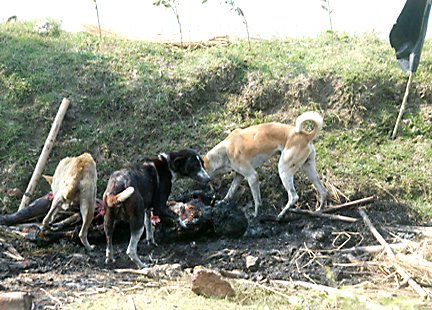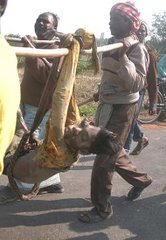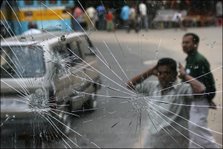| The east Asian model for development will not work in Bengal ABHIRUP SARKAR | |
| The author is professor of economics, Indian Statistical Institute, Calcutta | |
Raskolnikov, theoretically the murderer in Dostoevsky’s Crime and Punishment, had resolved to kill an old woman who was greedy, malicious, charged interest and was so sick that she was likely to die on her own in a month or so. By murdering and robbing her, Raskolnikov intended to make his mother happy, deliver his sister from her bondage, finish his university education, go abroad, and then for the rest of his life be honest, firm and unswerving in fulfilling his duties to humanity. Could his noble end justify his means? It was an ethical question and Dostoevsky took the moral stand that it could not. Moral stands are not fashionable these days. In these troubled times, when dozens and scores are getting murdered in the name of industrialization, in feuds over land acquisition, no one seems to bother about ethical questions. But quite apart from morality and ethics, there are practical issues too. Can we go ahead with our plans of industrialization in an awful mess like this? No doubt Buddhadeb Bhattacharjee has taken his drive for industrialization seriously. He and his party associates are Marxists seeking to achieve capitalist ends. To accomplish these ends, they are using private incentives and market forces along with coercion and brute muscle power. Being brought up in the Stalinist tradition of thinking, they are not too scrupulous about the methods they take to achieve their goals. For them, ends do justify the means. The drive for industrialization entailed wooing investors on the one hand, and acquiring land for industries and infrastructure on the other. Bhattacharjee and his deputies decided to woo the investors by giving them subsidies, incentives, tax breaks and low-interest loans. They have even gone to the extent of raising money from the market at the going rate of interest to finance these huge industrial subsidies, expecting future economic activities in the state to go up and yield so much tax revenue that the debt can be easily repaid. Quite expectedly, the endeavour had a favourable effect on potential investors and on those who were sympathetic to market-oriented reforms. As entrepreneurs gradually changed their perception about the state and seriously started considering West Bengal as their next investment destination, Bhattacharjee was hailed by a wide spectrum of people, cutting across party lines, industry houses and the different strata of society. The other part of the endeavour, the more important part in our opinion, was related to acquiring land for industrialization. Unfortunately, very little thought, energy and effort went into the planning of this part. Compensation and rehabilitation questions were largely ignored. Perhaps it was decided that the formidable political machinery of the party would take care of resentments arising out of eviction, and if verbal persuasion failed, brute force would be applied. In other words, when it came to the question of land acquisition, the Stalinist selves of Bhattacharjee and his party raised their ugly heads. The practice of using brute force to achieve economic ends was not confined to Stalin’s Soviet Russia alone. In the Britain of the late 16th and early 17th centuries, prospects of selling woollen manufactures in the European markets suddenly came up in a big way. Consequently, the village commons, which were cultivated till then on a communal basis, were enclosed for sheep-grazing. The peasant farmer was evicted from his traditional livelihood and the gentlemen sheepgrowers, armed with royal support, prospered along with the merchants and manufacturers. According to some estimates, 2.76 per cent of the total land was enclosed and 50,000 persons were forcefully evicted. This was no small number in a country whose total population around the year 1600 was about four million. Most historians agree that the enclosure movement, and the consequent eviction of tillers from land, led to large-scale conversion of farmers into a mass of vagrant and unemployable labour force gradually turning into beggars and thieves. The onslaught continues even today. According to the National Research Centre for Resettlement in China, forty five million people were displaced by development projects in that country between 1950 and 2000. The eviction, of course, involved a lot of brute force. There are, however, a couple of fundamental differences between 17th-century Britain, Stalinist Russia and the People’s Republic of China on the one hand and West Bengal on the other. Unlike the former set of countries, we do have a functioning democracy, however faulty it might appear to be. Moreover, our state is not even a country, it is only a small part of a larger nation. These differences have important bearings on the strategies we can possibly adopt for industrialization. Bhattacharjee’s government is trying to apply the east Asian model of development for the economic betterment of West Bengal. According to this model, the investor is treated like a king as long as he performs. He gets all possible benefits, subsidies and incentives from the government on the condition that he has to deliver. If he fails to do so, he is kicked out of the market because subsidies are often time-bound and short-lived. On the other hand, humanitarian considerations are largely kept aside if they hinder the investors’ interests. Land is taken away from the farmers for industrial use without much compensation and by force if necessary. Savage labour laws are imposed upon the workers. The buzzword is growth. Growth, and only growth, sanctifies all possible wrongdoing. The model has produced miracles in east Asia, certainly in terms of growth, though not always in terms of human development. But it can hardly work for West Bengal even to raise the rate of growth. For one thing, being a part of a larger country, West Bengal has to compete with other states to attract investment. But if we indulge ourselves in the expensive game of attracting investments by bidding up subsidies, we cannot punish the non-performer, for if subsidies are withdrawn the investor can threaten to pack up and move to some other region. A slower but much surer way is to attract the investors by building up good infrastructure and ensuring labour-market harmony. In the latter case, market forces can take care of non-performance and inefficiency. More important, the recent incidents in Nandigram and Singur, and the ensuing anger and protest they have generated all over the state and the country, clearly point to the fact that in a functioning democracy like ours, the coercive method of land acquisition is untenable, not only from a moral standpoint, but also as a matter of practical policy. Coercion worked only in countries where governments were authoritarian enough to suppress voices of protest, as in east Asia. Over the last few years, Bhattacharjee and his associates have been talking a lot about investors’ perception about West Bengal, about how it has improved over the years and how it ought to improve further in the near future. The Nandigram incident has sent a clear message to them. It has demonstrated that like the investors’ perception, the people’s perception about the process of industrialization is also important, probably more important in a functioning democracy. If the majority, or even a sizeable minority, perceives that industrialization is going to hurt, then it will be impossible to carry out. Bhattacharjee should read and understand this message. If he fails to do so, it will be a disaster for the state, because it is industrialization alone that can lift West Bengal from the depths of poverty and destitution. The Nandigram carnage should also teach the policy-makers that the means are as important as the ends. |
सीपीएम की क्रांति

हम एक लोकतंत्र में रह रहे हैं! 14 मार्च को हुई घटना और उसके बाद सीपीएम के बंद के दौरान गायब हुए दो सौ लोगों का अब तक कोई अता-पता नहीं है्. हां। कुछ लाशें हैं जो इलाके में इस हालत में पायी गयी हैं. क्या हम बता सकते हैं कि इन्होंने किस बात की कीमत चुकायी? क्या हम इसको लेकर आश्वस्त रह सकते हं कि हमें भी कभी ऐसी ही कीमत नहीं चुकानी पड़ेगी?
Wednesday, April 4, 2007
MEANS AND ENDS
Subscribe to:
Post Comments (Atom)
नंदीग्राम पर नयी फ़िल्म
यह फ़िल्म 14 मार्च की घटनाओं के सूक्ष्म विवरण के साथ आयी है.
देखें : नव उदारवाद का नया चेहरा बजरिये नंदीग्राम
देखें : विकास के नाम पर लोगों के उजड़ने की कहानी
उन्होंने मेरे पिता को टुकडों में काट डाला
देखें : न हन्यते
नंदीग्राम में 100 से ज्यादा लोग मारे गये हैं, 200 अब भी लापता हैं. वहां महिलाओं के साथ सीपीएम के कैडरों ने बलात्कार किया. बच्चों तक को नहीं छोड़ा गया है. सीपीएम की इस क्रूरता और निर्लज्जता का विरोध होना चाहिए. हमें नंदीग्राम, सिंगूर और हर उस जगह के किसानों के आंदोलन का समर्थन करना चाहिए, जो अपनी जमीन बचाने के लिए लड़ाई लड़ रहे हैं. यह दस्तावेज़ी फ़िल्म किसानों के इसी संघर्ष के बारे में है. यह फ़िल्म नंदीग्राम के ताज़ा नरसंहार से पहले बनायी गयी थी.
नंदीग्राम में जनसंहार के बाद के द्श्य
यह फिल्म पुलिस द्वारा नंदीग्राम में बर्बर तरीके से की गयी हत्याओं एवं उनकी भयावहता व बर्बरता के बारे में है. इसके कई दृ़श्य विचलित कर देनेवाले हैं.
नंदीग्राम प्रतिरोध्
नंदीग्राम में सरकारी आतंक
देखें : माकपा की गुंडागर्दी
नंदीग्राम में सीपीएम सरकार की पुलिस ने जो बर्बर कार्रवाई की, वह अब खुल कर सामने आने लगी है. यह फ़िल्म उसी बर्बरता के बारे में है. इसके कई दृश्य आपको विचलित कर सकते हैं. आप इसे तभी देखें जब आप वीभत्स दृश्य देख सकने की क्षमता रखते हों. हम खुद शर्मिंदा हैं कि हमें ऐसे दृश्य आपको दिखाने पड़ रहे हैं, पर ये आज की हकीकत हैं. इनसे कैसे मुंह मोडा़ जा सकता है?












No comments:
Post a Comment